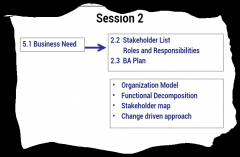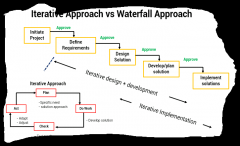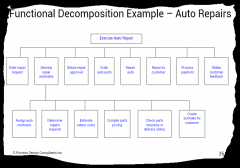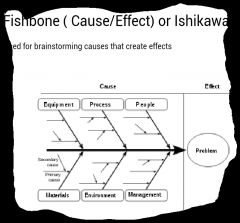![]()
![]()
![]()
Use LEFT and RIGHT arrow keys to navigate between flashcards;
Use UP and DOWN arrow keys to flip the card;
H to show hint;
A reads text to speech;
18 Cards in this Set
- Front
- Back
|
What are the three learning objectives discussed in session 2?
|
1) Change Driven Approach (identify different role of BA in this approach)
2) Organizational Model (to determine stakeholder list ) 3) Functional Decomposition (to identify stakeholder roles) 4) fishbone Chart (Use a Fishbone chart to brainstorm and plan the BA Activities required to achieve a goal ) |
|
|
What was Session 2's Process?
|

5.1 Business Need -> 2.2 Stakeholder List (roles and responsibilities) / 2.3 BA Plan.
|
|
|
There are degrees of Agile?
|
““The trick is to discover under what conditions agile methods are most likely to be successful-what’s known as “the sweet spot”. Kelly H.
|
|
|
How is Iterative approach different from Waterfall Approach
|

vs.
|
|
|
What is Change Driven Methodology also known as?
|
Iterative.
A methodology that focuses on Rapid delivery of solution capabilities in An incremental fashion and Direct involvement of stakeholders to Gather feedback on the solution’s performance (In a change driven approach the project is broken down into iterations or mini-projects) |
|
|
What do we need to know regarding who has what role in a project? (Organizational Modeling).
|
We need to know who has what role in Project
Responsible for the Process, Reviews Accountable for Business Results, Approves Contributes to the process, Consulted Impacted and needs to be Informed >> An Organizational Model will help identify these players and ensure no-one is left out of loop |
|
|
What is the definition of Functional Decomposition?
|

Definition:
A representation of the breakdown of processes into progressively increasing detail. The decomposition of business activities is represented with a process hierarchy diagram. The structure is a hierarchy. |
|
|
What is the purpose and usage of functional decomposition?
|
To decompose processes, functional areas, or deliverables into their component parts and allow each part to be analyzed independently.
To create a conceptual model of work that needs to be completed to deliver the new business functions. To provide all stakeholders with a consistent view of scope of the effort. To assist estimating in that estimates can be made for smaller, and therefore more readily understandable, subset of the whole. |
|
|
When creating a funcitonal decomposition diagram, who should you arrange a walk-through with?
|
A SME and other experts for further review and enhancements.
|
|
|
When would you use a Fishbone (cause/effect) diagram for?
|

Used for brainstorming causes that create effects. Also known as Ishikawa diagram.
|
|
|
What is a CED practioner?
|
need to check this out!
|
|
|
What does S.M.A.R.T stand for? (regarding common test for objectives).
|
Specific, Measurable, Achievable, Relevant, Time-Bounded.
Specific – describing something that has an observable outcome Measurable – tracking and measuring the outcome Achievable – testing the feasibility of the effort Relevant – in alignment with the organization’s key vision, mission, goals Time-bounded – the objective has a defined timeframe that is consistent with the business need |
|
|
What is a sponsor?
|
A sponsor must be identified within the organization who is responsible for making sure that the business need is met and who can authorize action to meet it.
|
|
|
What is a regulator?
|
Regulator: May impose new regulatory or governance requirements on the organization.
|
|
|
What is a business need (BABOK DEF)? (5.1)
|
A business need describes a problem that the organization is (or is likely to) face or an opportunity that it has not taken, and the desired outcome. The business need will guide the identification and definition of possible solutions.
|
|
|
When do we conduct Stakeholder Analysis?
|
After the business need has been identified:
This task covers the identification of stakeholders who may be affected by a proposed initiative or who share a common business need, identifying appropriate stakeholders for the project or project phase, and determining stakeholder influence and/or authority regarding the approval of project deliverables. Stakeholder analysis is performed as soon as a business need is identified and will usually be an ongoing activity as long as business analysis continues. Stakeholder analysis begins with identifying stakeholders who may be affected by the business need or a new solution. |
|
|
What is scope modeling?
|
Scope Modeling (9.27): Scope models should show stakeholders that fall outside the scope of the solution but still interact with it in some way.
|
|
|
What is RACI matrix?
|
[R]esponsible does the work,
[A]ccountable is the decision maker (only one) [C]onsulted must be consulted prior to the work and gives input [I]nformed means that they must be notified of the outcome The RACI matrix describes the roles of those involved in business analysis activities. It describes stakeholders as having one or more of the following responsibilities for a given task or deliverable: |

